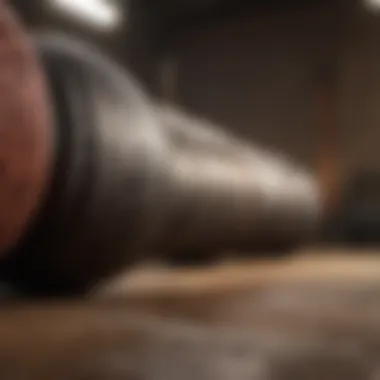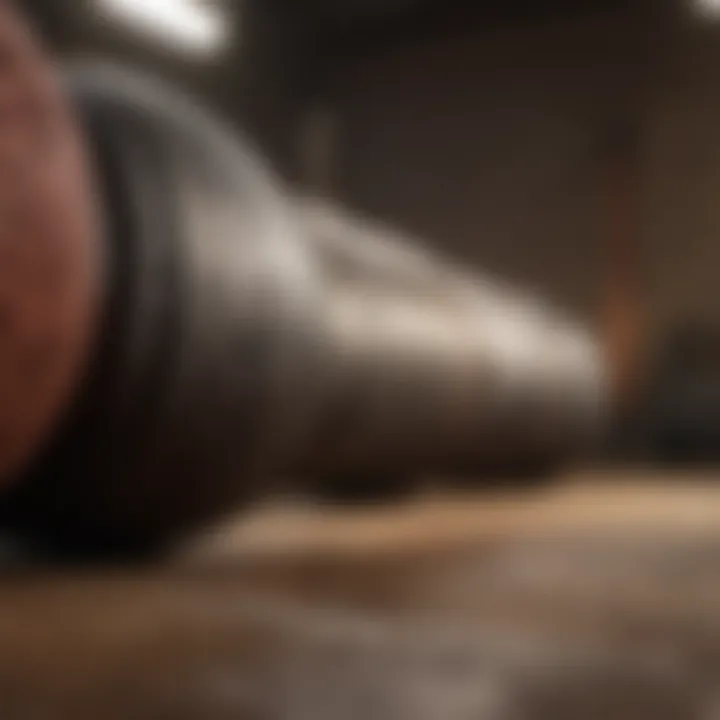Effective Home Remedies for Groin Pain Relief


Intro
Groin pain, while often overlooked, can be a significant source of discomfort and can arise from various factors. Whether due to an acute strain, a chronic condition, or even a sports injury, understanding how to manage this pain effectively at home is vital. This article aims to provide individuals with practical strategies for tackling groin pain while emphasizing the importance of accurately identifying the source of the discomfort.
Key Benefits
Addressing groin pain at home can yield multiple advantages. By focusing on treatment strategies, individuals can improve their physical health while simultaneously enhancing their mental well-being.
Physical Health Benefits
- Reduction of Pain: Through the right home treatments, individuals can experience a decrease in pain levels, which can improve their overall functioning.
- Enhanced Mobility: Strategies such as stretching and targeted exercises can help regain flexibility and strength, promoting better movement.
- Cost-Effective Solutions: Managing groin pain at home can save money compared to frequent visits to healthcare providers or specialists.
Mental Well-being Enhancements
- Increased Independence: Learning to manage pain independently can foster a sense of control and empowerment.
- Stress Relief: Engaging in mild exercises and relaxation techniques can alleviate mental stress associated with chronic pain.
According to various health sources, addressing pain at home is not only physically beneficial but can also have a profound positive impact on one’s mental health.
Practical Tips
Implementing practical strategies is crucial for effectively dealing with groin pain at home. Here are some attainable approaches that individuals can incorporate into their daily routines.
Initial Care Steps
- Rest: Taking a break from activities that exacerbate pain is essential; allowing time for recovery will aid healing.
- Ice Therapy: Applying ice can reduce swelling and numb the area, providing immediate relief.
- Compression: Using a compression garment can support the area and further decrease swelling.
Effective Meal Planning
A well-planned diet may support overall recovery and well-being. Consider including:
- Foods rich in omega-3 fatty acids like salmon and flaxseeds to reduce inflammation.
- Fresh fruits and vegetables to boost immune function.
- Hydration is key; drinking enough water can aid healing.
Quick and Efficient Workouts
Incorporating certain exercises can strengthen the groin and lower body to prevent future injuries. Here are a few examples:
- Gentle Stretching: Focus on stretches specifically targeting the groin area, like butterfly stretches.
- Strengthening Exercises: Gradually include resistance exercises, like squats or leg lifts, ensuring they are done without pain.
- Low-Impact Activities: Consider integrating activities like swimming or cycling which can enhance fitness without stressing the groin area.
Closure
Pain in the groin area is an issue that can impact one's daily life. However, understanding the steps to alleviate discomfort can lead to significant improvements in quality of life. The strategies highlighted in this article not only address immediate pain relief but also contribute to long-term health and well-being.
Understanding Groin Pain
Understanding groin pain is critical for proper management and recovery. The groin area is complex, housing muscles, tendons, and ligaments essential for movement. Recognizing the nature and sources of pain helps in determining the appropriate initial treatment and exercises. Knowing the causes and symptoms can significantly influence the recovery timeline and strategies employed.
What is Groin Pain?
Groin pain refers to discomfort or pain felt in the area where the abdomen meets the thigh. This pain can vary in intensity and can affect daily activities. It often emerges during physical activities like running or lifting objects and may create limitations in mobility. As a symptom, groin pain can signal various underlying issues, making a thorough understanding essential for effective self-care.
Common Causes of Groin Pain
Muscle Strains
Muscle strains are among the most prevalent causes of groin pain. Strains happen when muscles are overstretched or torn, commonly during sports or strenuous activities. The key characteristic of muscle strains is sudden or intense pain with movement. Recognizing a muscle strain is beneficial because it often responds well to initial home care like rest and ice therapy. However, if not managed properly, it can lead to longer recovery times.
Sports Injuries
Sports injuries often contribute significantly to groin pain. These injuries can stem from high-impact activities such as soccer, basketball, or running. A key factor is that sports injuries usually occur during sudden movements or changes in direction. Understanding this will help athletes and active individuals take preventive measures. However, sports injuries can sometimes be severe and may require professional treatment depending on their intensity.
Overuse Injuries
Overuse injuries are a common source of groin pain, especially among individuals who engage in repetitive activities. The key characteristic is pain that builds gradually, often becoming noticeable only during or after activity. Recognizing overuse injuries is important because they are typically manageable with proper rest and adjustment of activity levels. An advantage is that they highlight the importance of listening to one’s body in avoiding long-term issues.
Underlying Conditions
Underlying conditions, such as hernias or hip problems, can also lead to groin pain. These issues often present more complex symptoms, making it crucial to recognize them swiftly. The key characteristic is that pain may not only arise during physical activity but can be persistent or may worsen over time. Understanding this is beneficial as it could prevent complications. The disadvantage, however, is that management may involve medical professionals for diagnosis and treatment planning.
Identifying the Severity of Groin Pain
Recognizing the severity of groin pain can guide appropriate treatment options. Differentiating between mild and severe pain is a common yet crucial step.


Mild Pain vs. Severe Pain
Mild pain typically allows for some movement and may subside with rest and self-care measures. Severe pain often restricts activities and may indicate serious tissue damage. Knowing the difference is essential for determining whether to manage the issue at home or seek medical help. The advantage of identifying mild pain early is that it allows individuals to prevent escalation by taking suitable actions.
Acute vs. Chronic Pain
Acute pain arises suddenly and is often the result of injuries. It usually responds well to immediate care strategies. On the other hand, chronic pain persists over time and may require thorough assessment to find the underlying issue. Recognizing whether pain is acute or chronic can fundamentally influence treatment strategy. This distinction is valuable because it may dictate the immediacy of care needed, either for quick recovery or long-term management.
Initial Home Care for Groin Pain
Home care plays a crucial role in managing groin pain effectively. This section focuses on initial care steps that individuals can easily implement to alleviate symptoms. Prompt home care can limit further injury and aid in recovery. Practicing these methods ensures a structured approach towards healing while avoiding complications.
Rest and Activity Modification
Importance of Rest
Rest is essential for the body to recover from injury. Minimizing movement reduces stress on the groin area. This approach prevents worsening of potential strains or tears. Allowing the body time to heal is a widely recognized strategy in managing pain. While it may seem simple, rest is often overlooked in favor of maintaining usual activities.
Benefits of Rest include decreased pain and inflammation. It contributes positively towards an effective recovery process. Prioritizing rest means more efficient healing and allows for better focus on gradual recovery.
Gradual Return to Activity
Returning to daily activities requires a careful approach. After a period of rest, gradual resumption of movement is vital. This process helps to assess tolerance levels to strain on the groin. Instead of rushing back into full activity, a planned return can prevent aggravation of the injury.
A key characteristic of this approach is pacing. It reduces the risk of re-injury, fostering a more sustainable recovery. It allows listening to one's body, ensuring that each step is manageable. The unique feature of gradually returning is that it enhances recovery outcomes over time, balancing rest with movement.
Ice Therapy
How to Apply Ice
Ice therapy is a foundational element of initial care. Proper application of ice can significantly lessen pain and swelling. To apply ice effectively, wrap ice packs in a cloth to protect the skin. Place it on the affected area for optimal results.
The benefit of ice therapy lies in its ability to help constrict blood vessels, reducing swelling. This can lead to a decrease in pain levels. While it requires regular attention, the process is straightforward for home care.
Recommended Duration
The duration of ice application should be monitored. Typically, applying ice for 15 to 20 minutes every hour is effective. This timing allows for sufficient cooling without causing skin damage.
Following this duration offers a clear advantage as it creates a schedule that can fit into daily routines. Proper timing can lead to improved satisfaction with pain management results, contributing positively toward recovery.
Compression Techniques
Using Compression Wraps
Compression wraps are beneficial in supporting the groin area. They can limit swelling and provide stability to the muscles around the injury. Proper wrapping requires starting at the lowest part of the affected area and moving upwards. This ensures that compression is effective.
The key characteristic of compression wraps is their ability to provide consistent support. They can be easily adjusted as swelling decreases or as comfort needs change. This adaptability makes them a useful tool for home care.
Benefits of Compression
The benefits of compression extend beyond just support. It can help to improve circulation, thereby promoting healing. This feature plays a significant role in reducing recovery time.
As a method, it offers a straightforward way to control symptoms while staying active in recovery routines. Compression wraps have shown to be popular due to their ease of use and the prevalence of their effectiveness in clinical settings.
Elevation of the Affected Area
How to Elevate the Groin
Elevating the groin can assist in reducing swelling and promoting fresh circulation. To elevate, lie down and place a cushion under the legs. This simple method aids in draining excess fluid from the area. It is an easy practice to include in your recovery plan.
The unique feature of elevation is that it is a passive method requiring minimal effort. Along with rest, it complements other care methods. Many find it a comfortable option while allowing for other daily activities to continue.
Expected Outcomes
When elevating the groin area, individuals can expect decreased swelling and improved comfort levels. Consistent elevation can enhance overall recovery timelines. It serves as a proactive measure that contributes positively alongside other care techniques.
In summary, initial home care is fundamental for managing groin pain. Each method contributes meaningfully towards recovery. Following these guidelines ensures systematic treatment, paving the way for more advanced care strategies later on.
Exercises for Groin Pain Relief
Engaging in exercises specifically designed for groin pain relief is crucial for promoting recovery and reducing discomfort. These exercises help improve flexibility, strength, and balance, which are essential for the healing process. By easing tightness and strengthening the muscles around the groin, individuals can prevent future injuries and improve overall mobility. Each type of exercise focuses on different muscle groups, allowing for targeted relief and rehabilitation.
Gentle Stretching Exercises


Stretching plays a fundamental role in alleviating groin pain. It helps relax tense muscles and increase blood flow, enabling more effective healing. Gentle stretching exercises can address stiff areas, reducing overall discomfort and enhancing range of motion.
Adductor Stretch
The Adductor Stretch focuses on the inner thigh muscles, which are often a source of tension in groin pain. By stretching these muscles, individuals can alleviate discomfort and promote better flexibility.
One key characteristic of the Adductor Stretch is its simplicity. It can be performed almost anywhere without any equipment. The major advantage of this stretch is its ability to specifically target the adductors, making it an effective choice for groin issues. It is also popular because it accommodates various fitness levels, allowing individuals to modify the intensity to suit their needs.
Hip Flexor Stretch
The Hip Flexor Stretch is another essential exercise for groin pain relief. This stretch targets the hip flexors, which can become tight and contribute to pain in the groin area. Tight hip flexors often result from prolonged sitting or intense activity, making this stretch particularly beneficial.
A notable characteristic of the Hip Flexor Stretch is its engagement of the hip region, allowing for a deeper release of tension. This stretch is effective and popular among individuals, as it often brings immediate relief from tightness. However, it’s important to be cautious with this stretch; overextending can result in discomfort, so proper form is necessary.
Iliopsoas Stretch
The Iliopsoas Stretch is beneficial for targeting the iliopsoas muscle, which plays a significant role in hip movement. This muscle often contributes to groin pain when it is tight or strained.
The main defining feature of this stretch is its focus on the hip area, where many feel discomfort. It is beneficial for its ability to enhance flexibility and release built-up tension. However, one should take care not to overstretch, as this could inhibit the very relief it aims to provide.
Strengthening Exercises
While stretching is essential, strengthening the muscles around the groin is equally important. Strengthening exercises enhance muscular stability and resilience, supporting the body and reducing the risk of re-injury. These exercises are directed toward developing a robust core and strong surrounding muscles.
Bridges
The Bridges exercise activates the muscles of the glutes and core, providing support to the pelvis and lower body. This exercise can play a significant part in reducing groin pain by enhancing stability in the area.
A key characteristic of Bridges is that it is easy to perform and does not require special equipment. It is beneficial as it actively engages multiple muscle groups at once, promoting overall strength. A potential disadvantage might be that individuals with severe pain could find it challenging to perform this exercise initially.
Side-Lying Raises
Side-Lying Raises focus on the outer thigh and hip muscles, contributing to overall hip stability. This exercise is important for targeting the external muscles of the hip, which can mitigate stress in the groin region.
The benefit of this exercise lies in its ability to isolate specific muscles, reinforcing strength in those areas. An important consideration is ensuring proper alignment to avoid straining other muscles, which underscores the importance of technique while performing this exercise.
Clamshells
Clamshells effectively activate the gluteus medius, which is crucial for maintaining pelvic stability. Strengthening this area can provide significant relief from groin pain.
One of the advantages of Clamshells is that they can be done with minimal equipment, making them accessible for home workouts. They also allow for gradual increases in resistance, which is beneficial for ongoing progress. However, it is vital to perform this exercise correctly to fully realize its benefits and avoid potential discomfort.
Low-Impact Activities
In addition to targeted exercises, low-impact activities are essential for maintaining overall fitness while recovering from groin pain. These activities allow individuals to stay active without placing excessive strain on their groin.
Swimming
Swimming is an excellent low-impact activity that can help with groin pain recovery. The buoyancy of water reduces pressure on joints, allowing for movement without discomfort.
One major characteristic of swimming is its capacity for full-body engagement, which promotes strength and flexibility in a gentle way. The primary advantage is that it provides aerobic exercise with minimal risk of aggravating injuries. However, individuals should be cautious to avoid strokes that may strain the groin further.
Walking
Walking serves as a natural way to enhance mobility while managing groin pain. It encourages blood circulation and can aid in the rehabilitation process.
The benefit of walking lies in its simplicity and accessibility, making it an ideal option for many. Regular practice improves overall endurance. One downside might be walking's potential to exacerbate discomfort if done excessively or on uneven surfaces.
Cycling
Cycling is another significant low-impact activity that strengthens leg muscles while minimizing stress on the groin. It allows individuals to engage in aerobic exercise without harsh impacts.
Cycling’s major characteristic is its adaptability, as it can be done outdoors or with stationary bikes at home. The unique advantage is that it continuously engages the lower body in a controlled manner. However, incorrect positioning on the bike can lead to discomfort, making proper setup essential.
Preventive Measures for Groin Pain
Preventing groin pain is crucial for maintaining mobility and overall wellness. Groin injuries can develop from a variety of physical activities, making understanding preventive measures imperative. Engaging in preventive strategies not only aids in minimizing the risk of injury but also promotes ongoing physical health. By implementing simple yet effective practices, one can significantly reduce the likelihood of groin issues developing in the first place.
Warm-Up Techniques
A proper warm-up is essential before engaging in any physical activity. This increases blood flow to the muscles, enhancing flexibility. It's important to perform dynamic stretches and movements relevant to the activity planned. For instance, leg swings and arm circles can stimulate the groin area and prepare it for exertion. Aim for a warm-up lasting at least 10 to 15 minutes to ensure the muscles are adequately prepared.
Here are some warm-up techniques:


- Dynamic Leg Swings: Stand next to a wall or support. Swing one leg forward and backward, gradually increasing the range.
- High Knees: While standing, march in place, bringing your knees up as high as possible.
- Lateral Lunges: Step side to side and bend the knee to stretch the inner thigh and groin area.
Maintaining Flexibility
Flexibility is a critical component in preventing groin pain. Regular stretching can help maintain muscle elasticity and joint range of motion. It is advisable to incorporate a stretching routine into daily practice. When the muscles are flexible, they are less prone to strains. Focus on both static stretching after workouts and dynamic stretching before activities. This dual approach helps in promoting recovery and preparing the muscles for exertion.
Some effective stretches include:
- Seated Forward Bend: Sit and stretch towards your toes for hamstring and lower back flexibility.
- Butterfly Stretch: Sit with the soles of your feet together, pressing gently on your knees to open the hips.
- Figure Four Stretch: Lie on your back, place one ankle over the opposite knee and pull the thigh towards your chest.
Strength Training Importance
Strength training is often overlooked in discussions about injury prevention. However, building muscular strength in the core and lower body is vital for supporting the groin region. Strong muscles help in balancing loads across the pelvis, thus reducing strain. Incorporate specific exercises that focus on the hip adductors, glutes, and abdominal muscles. This can enhance stability and protect against injuries during physical activities.
Effective strength training exercises include:
- Squats: Enhance overall lower body strength.
- Lunges: Target specific muscles in the thighs and hips.
- Planks: Build core strength, which is essential for stability during movement.
By adopting these preventive measures, individuals can significantly decrease the risk of experiencing groin pain, enabling a more active and pain-free lifestyle. Prioritize these strategies to ensure long-term health.
When to Seek Medical Attention
Knowing when to seek medical attention for groin pain is essential for proper recovery and preventing further complications. Although many cases are manageable at home, some situations require professional evaluation to identify more severe issues or underlying conditions. Common red flags can help guide individuals in their decision-making. Understanding these signs aids in timely intervention, which can significantly enhance recovery outcomes. If you experience any of the following symptoms, consider consulting a healthcare professional.
Red Flags Associated with Groin Pain
Persistent Pain
Persistent pain is a key indicator that something may be seriously wrong. If discomfort continues despite home treatment measures like rest, ice, and over-the-counter medications, it warrants medical evaluation. Persistent pain is often characterized by a consistent and low-grade ache that either doesn’t improve or worsens over time. Understanding this symptom helps distinguish between ordinary soreness due to overuse and a sign of a more complex issue. Ignoring persistent pain can lead to prolonged injury or chronic conditions.
Swelling or Bruising
Swelling or bruising accompanying groin pain can indicate significant trauma or injury. While minor strains typically do not cause such symptoms, their presence suggests a more serious issue that may involve a tear or other soft tissue damage. The key characteristic of swelling is its visibility; if the affected area appears larger than usual, it may be a cause for concern. Bruising further indicates blood vessel damage. Seeking advice promptly can help prevent complications and ensure appropriate treatment.
Difficulty Moving
Experiencing difficulty moving is another warning sign. If normal movement patterns become limited due to groin pain, it is essential to seek professional guidance. Symptoms may manifest as inability to walk or perform everyday tasks without discomfort. This restriction is significant as it suggests more than just minor muscle strain. It highlights potential injury severity or the need for specialized intervention. Addressing movement issues early on can significantly reduce the risk of developing complications or worsening the condition.
Consultation with Healthcare Professionals
Once red flags have been acknowledged, understanding how to navigate the healthcare system becomes important. Recognizing the right type of medical professional to consult and adequately preparing for appointments can aid in efficient and effective care.
Types of Specialists
Physicians specializing in sports medicine, orthopedics, or physical therapy are often best suited to evaluate groin pain. Sports medicine specialists focus on diagnosing and treating injuries related to physical activity, while orthopedic surgeons deal with skeletal issues. Physical therapists can assist in rehabilitation and recovery. Each specialist brings unique expertise that can facilitate tailored treatment options. Engaging with the right professional after recognizing symptoms ensures a more successful recovery pathway.
Preparing for Your Appointment
Preparation for a doctor’s appointment can significantly improve the consultation experience. Gather relevant information, including medical history, a list of symptoms, and any treatments already attempted, before attending. This preparation provides the healthcare professional with context and enhances the quality of the consultation. Consider writing down questions or concerns to discuss during the visit. This proactive approach can lead to a more productive dialogue and facilitate informed decision-making for further treatment.
Summary and Key Takeaways
In discussing groin pain, it is essential to summarize the main points covered throughout the article. Groin pain can be complex but understanding how to manage it at home can lead to significant relief.
The importance of addressing groin pain lies in its potential to disrupt daily activities and limit mobility. Without proper attention, minor strains can escalate into chronic pain, possibly requiring professional intervention. Here are the crucial elements to remember:
- Initial Care: Rest, ice, compression, and elevation are fundamental. These steps promote healing by reducing swelling and inflammation.
- Exercises: Engaging in gentle stretching and strengthening exercises can aid in recovery and help prevent further injuries. Staying active with low-impact movements is vital for maintaining flexibility and strength.
- Prevention Strategies: Implementing effective warm-up techniques and maintaining overall fitness can minimize the risk of recurrence.
- Consulting Professionals: Recognizing when to seek medical attention is crucial. Symptoms like persistent pain or difficulty moving should not be ignored.
Ultimately, the goal of this article is to empower individuals in managing their own health. Understanding these takeaways allows for better self-care practices and promotes a proactive approach to handling groin pain.
"The best way to predict the future is to create it."
Adopting proper management strategies today can set a structure for a healthier future concerning groin health.
Final Thoughts on Managing Groin Pain
Managing groin pain effectively is about self-awareness and responsive care. Recognizing the symptoms and understanding their severity ensures timely interventions.
In addition, consistency in performing recommended exercises contributes significantly to recovery. It builds strength in the muscles around the groin, which can help avoid future injuries.
Practicing patience is essential during recovery. It is crucial not to rush back into high-impact activities too soon, as this can lead to reinjury. The road to recovery might take time, but with diligence and proper techniques, most individuals can achieve positive outcomes.
Resources for Further Information
For those looking for more information on groin pain and home treatment strategies, consider these reputable resources:
- Wikipedia on Groin Pain provides a broad overview of causes and potential treatments.
- Britannica on Pain Management elaborates on pain management techniques that may apply.
- Online communities like Reddit often have discussions on personal experiences with groin pain care and treatments.
By utilizing these resources, individuals can gain deeper insights into effective management strategies, contributing to enhanced knowledge and better personal care.















